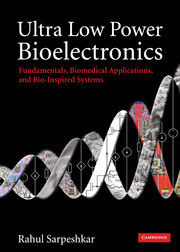Book contents
- Frontmatter
- Contents
- Acknowledgements
- Section I Foundations
- Section II Low-power analog and biomedical circuits
- Section III Low-power RF and energy-harvesting circuits for biomedical systems
- 16 Wireless inductive power links for medical implants
- 17 Energy-harvesting RF antenna power links
- 18 Low-power RF telemetry in biomedical implants
- Section IV Biomedical electronic systems
- Section V Principles for ultra-low-power analog and digital design
- Section VI Bio-inspired systems
- Section VII Energy sources
- Bibliography
- Index
- Epilogue
- References
17 - Energy-harvesting RF antenna power links
from Section III - Low-power RF and energy-harvesting circuits for biomedical systems
Published online by Cambridge University Press: 02 December 2010
- Frontmatter
- Contents
- Acknowledgements
- Section I Foundations
- Section II Low-power analog and biomedical circuits
- Section III Low-power RF and energy-harvesting circuits for biomedical systems
- 16 Wireless inductive power links for medical implants
- 17 Energy-harvesting RF antenna power links
- 18 Low-power RF telemetry in biomedical implants
- Section IV Biomedical electronic systems
- Section V Principles for ultra-low-power analog and digital design
- Section VI Bio-inspired systems
- Section VII Energy sources
- Bibliography
- Index
- Epilogue
- References
Summary
I do not think that the wireless waves I have discovered will have any practical application.
Heinrich Rudolph HertzUltra-low-power systems have the potential to operate in a battery-free fashion by harvesting energy from their environment. Such energy may take the form of solar energy in a solar-powered system, chemical energy from carbohydrates in an enzyme-based system, mechanical energy from vibrations in the system's platform, thermal energy in systems that exploit temperature differences between themselves and their environment, or radio-frequency electromagnetic energy in the environment. In Chapter 26, we shall discuss several forms of energy harvesting. In this chapter, we will focus on energy harvesting with radio-frequency antennas or rectennas as they are sometimes called.
Radio-frequency electromagnetic energy is increasingly becoming ubiquitous due to the growing presence of cellular phones, local area networks, and other wireless devices. Systems that operate by harvesting electromagnetic energy need an antenna for sensing electromagnetic waves and a rectifier for converting the sensed ac energy to a dc power supply. The created power supply can then be used to power an ultra-low-power system such as a radio-frequency identification (RF-ID) tag in a grocery store or a medical monitoring tag on the body of a person (see Chapter 20 on medical monitoring). In this chapter, we shall discuss important principles and building blocks for creating such RF-energy-harvesting systems including antennas and rectifier circuits. We shall discuss an example of a complete functioning experimental system to illustrate system-level tradeoffs. We begin by reviewing the fundamentals of antenna operation.
- Type
- Chapter
- Information
- Ultra Low Power BioelectronicsFundamentals, Biomedical Applications, and Bio-Inspired Systems, pp. 454 - 488Publisher: Cambridge University PressPrint publication year: 2010



